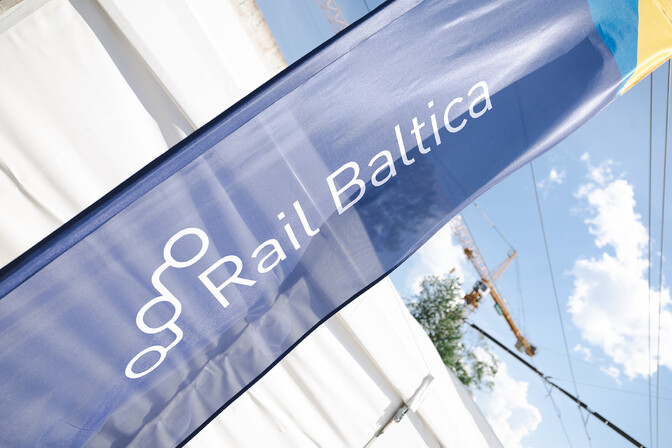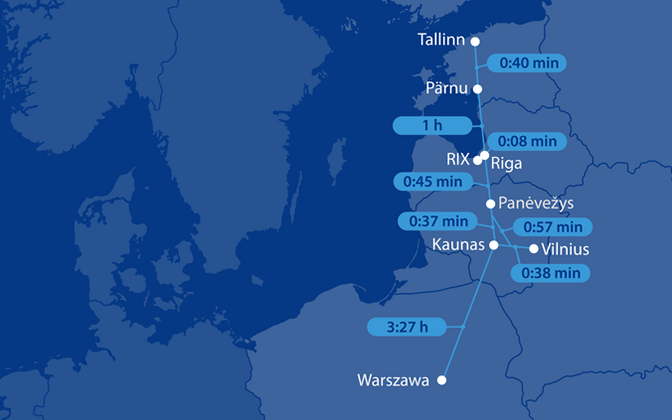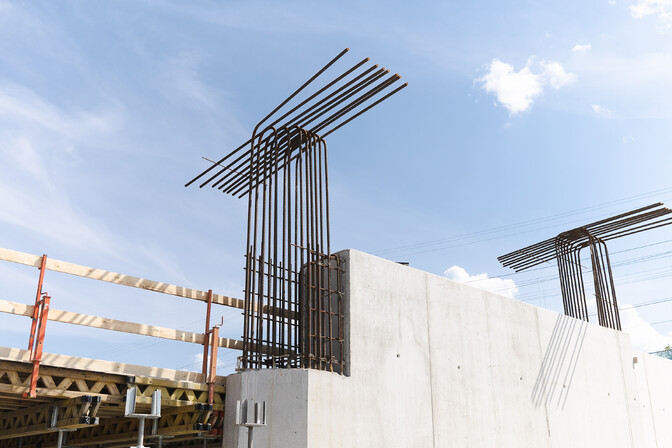
Yesterday the cornerstone was laid for Rail Baltic’s Ülemiste terminal. The terminal will cost about €50 million. Is now the right time to be building stations or should we concentrate on something else?
We need to begin somewhere and finish somewhere. My colleagues and partners in Estonia used to say “We are the periphery” and I said no you are not. You are the beginning, but also the endpoints, we want to connect before the connection to Finland. So for me, it’s the European big vision. So we need to have a railway station, of course.
But what is, of course, in our preoccupation is to have good planning, to finish in 2030, what we call the main line, not everywhere with a double track, but to have trains on it and people in trains. So this is also a necessity because it’s up to the capacities of construction. It is also linked to the budget. So we know now what was not [known] at the beginning of the project, a better cost estimation.
And we see that with this cost estimation, which is with everything in so it’s you know a big amount, it will not be the same in reality, it will be less. But, of course, we have references to begin and to discuss with companies and to see the part for each partner, the part of the Commission, the part of the states, and what must be looked for in the private sector and so on.
The budget for Rail Baltic has increased dramatically. In 2017, the Baltic states thought the whole project would cost €5.7 billion. Now we see that it is going to be approximately €25 billion – five times more. What do you think? What did we do wrong when we were planning? The budget increase has been far higher than inflation.
Yes, at first it was only an estimate. It was not a cost, so far as we can say, because it didn’t take all the environmental issues, technical issues [into consideration], we didn’t have any reference, so it was really an estimate. So, I was sure at the beginning that it would not be the final cost or the final estimation of the budget.
We lost a lot of time with discussions between the member states. I always said that it is costly to discuss governance, and other things, so much.
For example, you know, for the acquisition of land it was not a problem in Lithuania. In Latvia we didn’t have any law, it was very difficult and we needed this law which was adopted recently. So the acquisition of land was very late. So, the calculation of the construction when you don’t know the value of the land is something that is difficult.
But finally, the cost when I discuss with companies working on construction, like we see in Estonia, the prices are less. So we know that it will change, the costs will not rise in the first phase, but become more realistic way, they will diminish.
So now we have an idea of what is expected, we have this scheme for the financial gap which needs to be completed and we will have guarantees to look for private money. Now we can move to construction and we can have real costs to show and also the credibility and the legitimacy of the project.

Let’s talk about this first phase. Have you received any joint plans from the Baltic States? What will the first phase be?
From their side, I was, as coordinator, asking for the mobilization. There is a 15 percent cost obligation. This was the rule from the outset.
The calculation of the 85 percent was also because we estimated the cost of the project to be lower. So now we are engaged with this percentage. We think that it will continue. This is good news, of course, because it’s European money and given by all the taxpayers in Europe.
So we also need to have a really responsible attitude from the Baltic states to bring their own plans. So we will have this joint agreement between us, between them first, for the 2030 plan, the first phase, the perspective of the second phase, and the continuity of the project, which is a really big condition.
And of course, the engagement of the Commission. New elections are always risky for such a project, because the attitudes of governments are different sometimes. But now, I think it will be good because it is underway. There is no more debate about whether to go ahead or not. The project is really on a good track.
I understand the Baltic states have agreed on the main points for the first phase. For example, one of the most important agreements is that the rail track should go through Riga. It will cost about €300 million before 2030.
Do you agree that Riga should be connected to the main line?
Of course, it is part of the project because it’s the connection to capital cities and it’s an obligation like Vilnius. But like Vilnius, we cannot just do all the work in the first phase. So there will be and it was the discussion recently with RB Rail and with the Latvian authorities I discussed it with the minister of transport to look at how we can have an intermediary period to connect Riga but not with the final high-level installations.
So the connection with [Riga Airport] by train is very important. So we try to connect obligations of connections, but with a cost that is feasible in the first phase. Then the same for Vilnius. There will be also some work to improve the connection and then in the second phase we will have the final Investments and for Lithuania we need to have the connection to Poland for security reasons, we need to have a double track until Kaunas [from the Polish border].
To be clear, the solution involves building the southern entrance to Riga, but not the connection to Vilnius, and a double track between Kaunas and Poland with a cost of about €15 billion. Is that also suitable for the Commission?
You know, what we ask for, and me personally explicitly, is that we must do the project with efforts to reduce the final envelope [price]. So this is still the duty of the three Baltic states and the three implementing companies, the national companies and RB Rail. So they continue to work and find some solutions. So I know that they will not be able to reduce it by too much.
But if we agree that we can rely on some loans, some public-private partnerships in several parts of the project, and also perhaps the creation of a tool for these loans. We are in discussion about the capacity to reuse what is not spent by member states, which is necessary for the project. So we see all of the solutions are now on the table to finalize the financial support.
So I don’t have it in my hands now, but my discussion last week with the minister of finance in Latvia, in Riga, was really, really positive. I said, okay, now the ministries of finance must be in the game, they must contribute, they must be innovative, and they must also discuss with the ministers of transport and not see the ministers of transport always like the people who are spending a lot of money, but also [bringing in] revenues. When you see that when you have the infrastructure and the trains for cargo and citizens and travelers, you increase your attractiveness.
But I’m sure we see that with the trains reopening, the Amber train, the connection between Vilnius and Riga, there are people in the trains. They are full. So we know that there is demand. There are more and more investments. I saw them in the port of Tallinn. So I discussed also this in Hamburg. At first, I had to convince them to be interested, but now they see that Rail Baltic is coming. So I think that now we have all the arguments and we see investments coming.

I’ve seen different funding forecasts prepared by RB Rail and the most optimistic ones suggest that the European Commission will pay around €10 billion for Rail Baltic. These are the most optimistic estimates. Do you think these are realistic forecasts or rather optimistic ones?
At the moment, I don’t know. I was a member of parliament, I remember the battle to have the CEF [Connecting Europe Facility]. I know the demands made to the Commission for more than €6 billion for military mobility and only €1.7 billion obtained.
We need a better CEF, because now all the projects are more mature. So the competition is much higher than before. So we know that it can be also a problem then if the budget is not big enough. So, the first step is obtaining a bigger budget and more capacity.
The second thing, the member states can also argue for is that the investments made in the construction of the TEN-T infrastructure are not included in the calculation of the country’s debt burden. There is every reason for this. If the member states make efforts with their budgets, then we have to respond. Plus the budgets of the Baltic countries are not as large as those of France or Germany.
I prefer to talk concretely about the issues that need to be resolved, because I am not sure that we can imagine in our optimistic dreams that we can put €10 billion on the table. And we have elections on the 9th of June and we never know what will happen with the new parliament and the new political situation.
The European Commission is currently investing 3.8 billion euros in the project. And it is conceivable that the commission will put as many of you there. To go from there to ten billion, you know, that’s…
The Commission put €3.8 billion into the project. This is conceivable that the same amount could come again… But to go from there to €10 billion, it’s…
But even when we get this optimistic forecast – €10 billion – it’s about 60-70 percent, it’s not 85 percent.
No, but if we can maintain the 85 percent, which was not evident at first, this will be a big thing. If we stick to the budget, this will not be the optimum we hope for, but this will be a good situation.
For the moment, my preoccupation is to say to the three Baltic states, you got more than three billion, please spend it. Spend the money, because if not, you will lose it.
We want Rail Baltic to maintain a priority. We want to continue to have the same percentage of contribution and we hope that we can have the maximum during this first phase to facilitate the second. We need to have several scenarios, optimistic, middle optimistic…
What is needed now is the engagement of the member states so that they can do their job on their part, to find a way to complete the financial support and we will help them with it, and then finalize the agreement, to have the certainty that we will build it and to have the capacity to continue.
Do you suggest that Riga’s connection should be done with a private-public partnership?
It must be verified if this is feasible or not, the discussion is ongoing at the moment. The identification of parts of the project which are attractive for private-public partnership. Of course, we have examples of private-public partnerships in my country [France], in other countries, in Europe which were good experiences, but some were less good, if I can say that. Sometimes it was also costly.
So we need to carefully choose the right ones. So it is the task of RB Rail to finalize these calculations with the contribution of the national companies and with their interlocutors in the government.
I would like to give the readers as clear an overview as possible of what can be done with these €15 billion. In other words, how much of it will be borne by the EU, how much must be found in the private sector and how much will be borne by the budgets of the member states. What is your understanding of this?
To do this, we should be sure how much money will come from EU funding. So this will be finalized in the agreement.
At the moment, the Commission wants to speak about concrete and credible figures. And this €15 billion, for me, it’s a maximum. Then we look precisely what are the costs we can take with the CEF money.
So my message is to do what you can as member states, please do it and take initiative. The member states, cannot wait for European money. They also have to put in what they can contribute because it can be helpful to find private-public partnerships or to improve the budget So I think we are in this period of discussion, but I’m glad that it is starting.

—
Follow ERR News on Facebook and Twitter and never miss an update!






